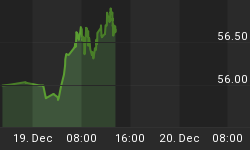Thanksgiving and Black Friday are the biggest shopping seasons of the year for the retail and consumer discretionary sectors, but no one really seems to be shopping for gold. Instead, gold markets have remained depressed over Thanksgiving through Black Friday as a firmer dollar and retreating oil prices kept the yellow metal in check.
Gold futures prices eased in Black Friday’s shortened session, managing to end the week barely in positive territory. Gold for December 18 delivery [s:GCZ8] fell $4.60, or 0.37 percent, to $1,223.40 an ounce. The contract finished up a mere tenth of a percentage point for the week. Spot gold slipped $4.40 on Black Friday to $1,225.80, flat for the week.
Weaker Euro Pushes Dollar Up
The dollar finished the day with a 0.27 percent gain against its key rivals as the euro slipped on weaker eurozone economic growth. The U.S. dollar index, which pits the greenback against six trade-weighted world currencies, climbed 0.27 percent to 96.84.
Business growth in the eurozone has slowed this month thanks to a U.S.-led trade war and a generally slowing global economy. Sentiment in the eurozone’s economic growth prospects were further dampened by worrying data coming from the region’s largest economies.
Markit’s flash composite Purchasing Managers’ Index (PMI) data has revealed that German’s private-sector growth has slowed to a four-year low. Meanwhile, Italy’s growing debt burden continues to be a major source of worry for the bloc, with the country’s central banks now warning that rising bond yields will only serve to exacerbate the problem.
European Central Bank (ECB) policymakers have a target to start winding down their bloated €2.6 trillion asset purchase program sometime at the tail end of the year. The OECD has forecast that growth in the euro area will slow down from nearly 2.0 percent in 2018 to around 1.6 percent in 2020.
Any more signs of weakness from member states might lead to a delay in QE, which will increase the volatility of the euro even further to the dollar’s advantage. Related: The Ultimate Guide To Buying Discount Gold
A strong dollar has been largely to blame for gold’s poor showing in 2018. Gold prices have dropped six percent in the year-to-date compared to a seven percent climb by the dollar index.

(Click to enlarge)
Source: Apmex

(Click to enlarge)
Source: Investing.com
Meanwhile, the global economy is not slowing rapidly enough to support higher gold prices despite ongoing trade tensions and higher interest rates.
According to the OECD, global economic growth is likely to slow from 3.7 percent this year to 3.5 percent in 2019—which is still a pretty decent rate. Growth is expected to remain quite strong in OECD countries while non-OECD countries and emerging economies will see a sharper slowdown. The OECD has already cut its outlook for China, Russia, Brazil, Turkey and South Africa.
What gold needs right now for a strong rebound is a hard landing to rattle the markets, but that just doesn’t look likely to happen in the near future, trade tensions notwithstanding. According to OECD chief economist Laurence Boone:
“We’re returning to the long-term trend. We’re not expecting a hard landing, however, there’s a lot of risks. A soft landing is always difficult. ”
Related: Illegal Gold Mining Hits Record High In Venezuela
The long-term trajectory for gold is not being helped by falling oil prices either. An energy model developed by Gold Money Inc. says that fluctuations in long-term energy prices has a direct effect on gold prices. That’s perfectly understandable since energy is a major factor of production for gold and other commodities. Higher oil prices usually lead to higher gold prices in the long-term.
Crude prices have dropped more than 10 percent over the past seven days alone and 33 percent from October highs.

(Click to enlarge)
Source: Nasdaq
With Saudi Arabia cozying up to the Trump administration so much, oil prices might not be going anywhere near their recent multi-year highs any time soon.
By Alex Kimani for Safehaven.com
More Top Reads From Safehaven.com:
















